
PASCACK VALLEY—It is confidently predicted this county will be the home of approximately one million people. That’s what Mr. Walter Phillip Shatts, field secretary of the Regional Plan Association of New York, said when he spoke in Westwood on May 21, 1934.
Ninety years ago, Shatts had interesting predictions about the region. He was correct that Bergen County would be home to approximately a million people. The population is now greater than 950,000, so we are not far off. Shatts was somewhat off in his timeline, however: He predicted we would hit the mark in 1965.
His talk was “Westwood and the Regional Plan of New York and Environs.”
“For decades Bergen County has grown apace. In the 10 years from 1920 to 1930, its population jumped from 210,643 to 364,977. At the end of the next decade, it is estimated that the population will have increased to 547,000.”
There he was right on the money. By the end of the 1940s, Bergen County was home to about 540,000 people. The post-World War II Baby Boom and suburban sprawl, facilitated in large part by the construction of the George Washington Bridge, resulted in a population explosion in the mid-20th century. New homes were being built everywhere.
By 1960, there were 780,000 people in Bergen. By 1970, there were almost 900,000.
If the trajectory had continued, we would have not only reached one million, we would have far surpassed it. While expansion has continued since the 1970s, it has happened at a much slower pace.
Nowadays, instead of immense swaths of woods and farmland becoming entirely new neighborhoods, we see smaller pockets of redevelopment as properties come on the market. To put it simply, we ran out of dirt.
It would have been difficult for people of the 1930s to imagine our current lack of open space. As the decade began, parts of the Pascack Valley were still largely rural and undeveloped. In 1930, River Vale and Woodcliff Lake both had about 870 residents. The Township of Washington had 400. Land is now at a premium in all those communities.

Westwood was by far our largest town by population, and it grew quickly. In 1870, when the railroad came through, 25 houses stood in the entire village. In 1900, with growth facilitated by the railroad, there were 828 people. By 1930, more than 4,860 people were in Westwood.
We wonder what this phenomenon was like for older folks who remembered those earlier rural days. It must have seemed like an invasion.
And it was just getting started—by 1970, there were 11,000 people.
“To accommodate this increasing population, allow for the expansion of industry, and make more attractive the undeveloped residential and recreation areas, there must be prompt and intelligent planning,” Shatts cautioned in 1934.
He told the people of Westwood, “The natural water supply must be controlled…a system of parks, parkways, and boulevards developed, and airports established. Proper guidance must be given to the planning of undeveloped areas, the zoning of both developed and undeveloped areas, the regulation of housing, and the location and architecture of public buildings. Much must be done, and how it is done will be a matter of deep interest to every taxpayer and resident of the county.”
